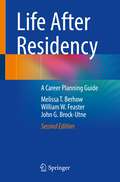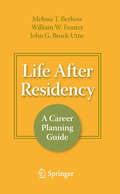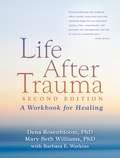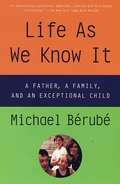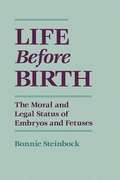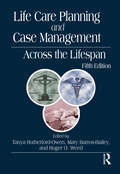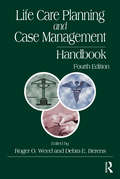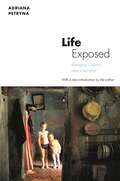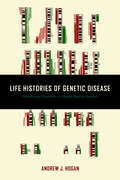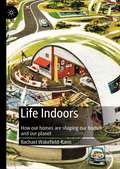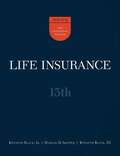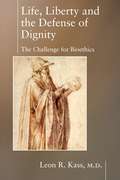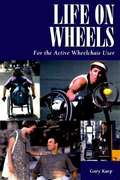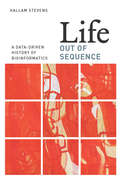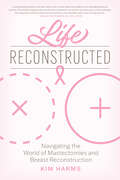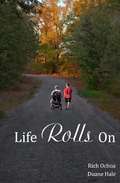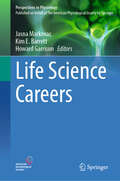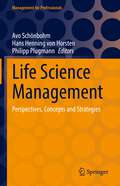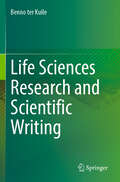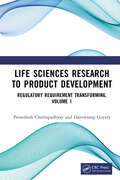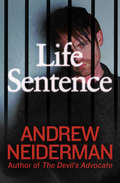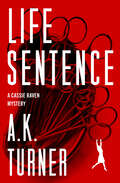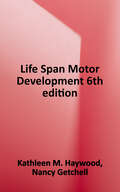- Table View
- List View
Life After Residency: A Career Planning Guide
by Melissa T. Berhow William W. Feaster John G. Brock-UtneThis 2nd edition has been updated and offers residents an even more useful, step-by-step guide to achieving a successful and fulfilling career in medicine. The book's authors began running seminars at Stanford to advise their residents on various important topics not traditionally taught in medical school or residency, but all essential for establishing a successful career in medicine. These topics include creating a curriculum vitae and landing a great job, financial advice for student loans and retirement planning, understanding malpractice insurance, applying to medical staffs, and other important topics. Each chapter from the previous edition is expanded and updated. New chapters have been added to address the following key topics:· EMRs· Payment for services· Leadership· Understanding hospital administration· Physician wellnessLoaded with sage advice and practical wisdom, Life After Residency, 2nd Edition continues to be an invaluable asset for every resident during the transition from residency to life thereafter.
Life After Residency: Increase Your Brain's Creativity, Energy, And Focus
by Melissa T. Berhow William W. Feaster John G. Brock-UtneLife After Residency: A Career Planning Guide is an insightful, step-by-step guide to achieving a successful and fulfilling career in medicine. As professors at Stanford University Medical Center, Drs. Melissa Berhow, William Feaster, and John Brock-Utne began running seminars to advise their residents not only on creating a curriculum vitae and landing a great job, but also on how to manage student loan payments and avoid pitfalls in the life of a physician. The immense success and ensuing demand for more seminars eventually gave rise to Life After Residency--a book which continues the seminar discussions in greater depth and magnitude, while maintaining a conversational writing style. Key topics covered include: preparing for a job interview, evaluating job offers and negotiating contracts, obtaining and maintaining the proper State license, applying for membership onto Medical Staffs, obtaining malpractice insurance, buying a house and investing for eventual retirement, and pursuing non-medical career options. Loaded with sage advice and practical wisdom, Life After Residency is an invaluable asset to every resident during the transition from residency to life thereafter.
Life After Trauma: A Workbook for Healing, 2nd Edition
by Dena Rosenbloom Mary Beth Williams Barbara E. WatkinsTrauma can turn your world upside down--afterward, nothing may look safe or familiar. This compassionate workbook has already helped tens of thousands of trauma survivors start rebuilding their lives. Full of practical strategies for coping and self-care, the book guides you toward reclaiming a solid sense of safety, self-worth, trust, and control, as well as the capacity to be close to others. The focus is on finding the way forward in your life today, no matter what has happened in the past. The updated second edition has a new section on managing emotions through mindfulness and an appendix on easing the stress of health care visits. Dozens of step-by-step questionnaires and exercises are included; you can download and print additional copies of these tools for repeated use.
Life And Death In Intensive Care
by Joan CassellLife and Death in Intensive Care offers a unique portrait of the surgical intensive care unit (SICU), the place in medical centers and hospitals where patients with the gravest medical conditions—from comas to terminal illness—are treated. Author Joan Cassell employs the concept of "moral economies" to explain the dilemmas that patients, families, and medical staff confront in treatment. Drawing upon her fieldwork conducted in both the United States and New Zealand, Cassell compares the moral outlooks and underlying principles of SICU nurses, residents, intensivists, and surgeons. Using real life examples, Life and Death in Intensive Care clearly presents the logic and values behind the SICU as well as the personalities, procedures, and pressures that characterize every case. Ultimately, Cassell demonstrates the differing systems of values, and the way cultural definitions of medical treatment inform how we treat the critically ill.
Life As We Know It: A Father, a Family, and an Exceptional Child
by Michael BerubeJamie was born with Down syndrome. He was immediately subject to the medical procedures, insurance and representations as our society designates him as disabled. This book describes not only the challenges of raising him but the challenge of seeing him as a person.
Life Before Birth: The Moral and Legal Status of Embryos and Fetuses (2nd Edition)
by Bonnie SteinbockThis book provides a framework for thinking clearly and coherently about the unborn. The book's thesis, the "interest view," states that all and only beings who have interests have moral standing, and only beings who possess conscious awareness have interests. The chapters apply the interest view, and explore the moral and legal aspects of a wide range of issues.
Life Care Planning and Case Management Across the Lifespan
by Roger O. Weed Tanya Rutherford-Owen Mary Barros-BaileyCelebrating 25 years since its first publication, the fifth edition of this best-selling text is the most up-to-date and complete resource available on what a life care planner does, how the life care planner does it, and issues that affect the day-to-day role of a life care planner. Now featuring new material on pediatric life care planning and case management, including brachial plexus injuries and neurodevelopmental disorders, this new edition provides guidance and planning for cases across the lifespan. It begins with a series of chapters examining ten different professional specializations that often contribute to a life care plan, before providing critical information for developing life care plans for individuals with different physical, mental, and cognitive conditions including spinal cord injury, brain injury, and chronic pain. Uniquely comprehensive, the book also includes chapters on the forensic and legal context of life care planning, as well as equipment/technology, evidence-based literature/resources, and special education/special needs planning relevant to pediatric life care planning. Also including chapters dedicated to life care planning methodology and life care planning research, this is an essential resource for anyone practicing or studying life care planning or managing the needs of those requiring chronic medical care over the lifespan.
Life Care Planning and Case Management Handbook
by Roger O. Weed Debra E. BerensLife care planning is an advanced collaborative case management specialty practice focused on assessing, evaluating, coordinating, consulting, planning for, and monitoring necessary services for individuals with complex medical care needs over their lifetime. This handbook provides a comprehensive resource for all people involved with catastrophic impairments and chronic medical care case management. The Life Care Planning and Case Management Handbook, Fourth Edition, begins by defining the roles played by each of the key team members working with the life care planner. It provides planners with insights critical to successful interactions with medical and health care–related professionals as well as the team members they are most likely to encounter as they work to build an accurate and reliable life care plan. Next, the text offers up-to-date information on the medical conditions most frequently encountered by the life care planner. The contributors, who are recognized experts in their disciplines, also address issues in forensic settings, ethics, standards, research, and credentials. The fourth edition includes numerous chapters on general issues, as well as updated standards of practice from the International Academy of Life Care Planners (IALCP), Life Care Planning Consensus Statements, and valuable step-by-step charts and checklists. Completely updated and expanded, this revised handbook now includes new chapters on multicultural considerations in life care planning, admissibility of life care plans in U.S. courts, and Canadian life care planning practice. Additionally, infused in other chapters, is new information on medical coding and costing for life care planners, life care planning in non-litigated contexts, as well as research and education within life care planning.
Life Exposed: Biological Citizens after Chernobyl (In-formation Ser.)
by Adriana PetrynaOn April 26, 1986, Unit Four of the Chernobyl nuclear reactor exploded in then Soviet Ukraine. More than 3.5 million people in Ukraine alone, not to mention many citizens of surrounding countries, are still suffering the effects. Life Exposed is the first book to comprehensively examine the vexed political, scientific, and social circumstances that followed the disaster. Tracing the story from an initial lack of disclosure to post-Soviet democratizing attempts to compensate sufferers, Adriana Petryna uses anthropological tools to take us into a world whose social realities are far more immediate and stark than those described by policymakers and scientists. She asks: What happens to politics when state officials fail to inform their fellow citizens of real threats to life? What are the moral and political consequences of remedies available in the wake of technological disasters? Through extensive research in state institutions, clinics, laboratories, and with affected families and workers of the so-called Zone, Petryna illustrates how the event and its aftermath have not only shaped the course of an independent nation but have made health a negotiated realm of entitlement. She tracks the emergence of a "biological citizenship" in which assaults on health become the coinage through which sufferers stake claims for biomedical resources, social equity, and human rights. Life Exposed provides an anthropological framework for understanding the politics of emergent democracies, the nature of citizenship claims, and everyday forms of survival as they are interwoven with the profound changes that accompanied the collapse of the Soviet Union.
Life Histories of Genetic Disease: Patterns and Prevention in Postwar Medical Genetics
by Andrew J. HoganA history of genetic testing warns that such tests may tell us more than we want to know.Medical geneticists began mapping the chromosomal infrastructure piece by piece in the 1970s by focusing on what was known about individual genetic disorders. Five decades later, their infrastructure had become an edifice for prevention, allowing today’s expecting parents to choose to test prenatally for hundreds of disease-specific mutations using powerful genetic testing platforms. In Life Histories of Genetic Disease, Andrew J. Hogan explores how various diseases were "made genetic" after 1960, with the long-term aim of treating and curing them using gene therapy. In the process, he explains, these disorders were located in the human genome and became targets for prenatal prevention, while the ongoing promise of gene therapy remained on the distant horizon.In narrating the history of research that contributed to diagnostic genetic medicine, Hogan describes the expanding scope of prenatal diagnosis and prevention. He draws on case studies of Prader-Willi, fragile X, DiGeorge, and velo-cardio-facial syndromes to illustrate that almost all testing in medical genetics is inseparable from the larger—and increasingly "big data"–oriented—aims of biomedical research. Hogan also reveals how contemporary genetic testing infrastructure reflects an intense collaboration among cytogeneticists, molecular biologists, and doctors specializing in human malformation.Hogan critiques the modern ideology of genetic prevention, which suggests that all pregnancies are at risk for genetic disease and should be subject to extensive genomic screening. He examines the dilemmas and ethics of the use of prenatal diagnostic information in an era when medical geneticists and biotechnology companies have begun offering whole genome prenatal screening—essentially searching for any disease-causing mutation. Hogan’s focus and analysis is animated by ongoing scientific and scholarly debates about the extent to which the preventive focus in contemporary medical genetics resembles the aims of earlier eugenicists. Written for historians, sociologists, and anthropologists of science and medicine, as well as bioethics scholars, physicians, geneticists, and families affected by genetic conditions, Life Histories of Genetic Disease is a profound exploration of the scientific culture surrounding malformation and mutation.
Life Histories of Genetic Disease: Patterns and Prevention in Postwar Medical Genetics
by Andrew J. HoganA richly detailed history that “uncovers the challenges and limitations of our increasing reliance on genetic data in medical decision making” (Shobita Parthasarathy, author of Building Genetic Medicine).Medical geneticists began mapping the chromosomal infrastructure piece by piece in the 1970s by focusing on what was known about individual genetic disorders. Five decades later, their infrastructure had become an edifice for prevention, allowing expectant parents to test prenatally for hundreds of disease-specific mutations using powerful genetic testing platforms. In this book, Andrew J. Hogan explores how various diseases were “made genetic” after 1960, with the long-term aim of treating and curing them using gene therapy. In the process, he explains, these disorders were located in the human genome and became targets for prenatal prevention, while the ongoing promise of gene therapy remained on the distant horizon.In narrating the history of research that contributed to diagnostic genetic medicine, Hogan describes the expanding scope of prenatal diagnosis and prevention. He draws on case studies of Prader-Willi, fragile X, DiGeorge, and velo-cardio-facial syndromes to illustrate that almost all testing in medical genetics is inseparable from the larger—and increasingly “big data”–oriented—aims of biomedical research. Hogan also reveals how contemporary genetic testing infrastructure reflects an intense collaboration among cytogeneticists, molecular biologists, and doctors specializing in human malformation.Hogan critiques the modern ideology of genetic prevention, which suggests all pregnancies are at risk for genetic disease and should be subject to extensive genomic screening. He examines the dilemmas and ethics of the use of prenatal diagnostic information in an era when medical geneticists and biotechnology companies offer whole genome prenatal screening—essentially searching for any disease-causing mutation. Hogan’s analysis is animated by ongoing scientific and scholarly debates about the extent to which the preventive focus in contemporary medical genetics resembles the aims of earlier eugenicists. Written for historians, sociologists, and anthropologists of science and medicine, as well as bioethics scholars, physicians, geneticists, and families affected by genetic conditions, Life Histories of Genetic Disease is a profound exploration of the scientific culture surrounding malformation and mutation.
Life Indoors: How our homes are shaping our bodies and our planet
by Rachael Wakefield-RannIn this timely and expansive book, Wakefield-Rann investigates how emerging disease ecologies are undermining definitions of health and immunity that have persisted since the 19th century, and had a formative influence over the design of not only homes, but entire cities. This wide-ranging account traces the links between the history of medicine, modernist design and architecture, the rise of inflammatory disease, the microbiomes of buildings and humans, antimicrobial resistance, and novel chemical pollutants, to show how indoor environments have made us as we have made them. In highlighting the processes that have been missed in designing perfectly controlled interior habitats, Life Indoors shows the limitations of dominant practices, classifications and philosophies to apprehend current indoor pathogen ecologies.
Life Insurance
by Kenneth Black Jr Harold D Skipper Kenneth Black IIIThis 15th edition of Life Insurance is published in recognition of the 100th anniversary of this book's first edition. That edition was published in 1915 and authored by Dr. Solomon S. Huebner, founder of the Wharton School's insurance program and of the Chartered Life Underwriter certification program. It was pioneering for setting out both insurance principles and practices in a single, expansive treatise aimed explicitly at students of the business, whether they were students in the traditional collegiate sense or those undertaking professional development studies. This edition continues that legacy. While the 14th edition represented a sweeping revision and was published not long ago, several factors compelled us to bring forward this edition. These included a desire to update several vitally important sections, such as the tax treatment of life insurance and the implementation of the Health Care and Affordability Act of 2010. We also discovered several portions of the 14th edition that needed clarification and others that benefitted from a deeper treatment. We also corrected several errors identified by helpful readers.
Life Liberty & the Defense of Dignity
by Leon KassAt the onset of Life, Liberty and the Defense of Dignity, Leon Kass gives us a status report on where we stand today: "Human nature itself lies on the operating table, ready for alteration, for eugenic and psychic 'enhancement,' for wholesale redesign. In leading laboratories, academic and industrial, new creators are confidently amassing their powers and quietly honing their skills. For anyone who cares about preserving our humanity, the time has come for paying attention." Trained as a medical doctor and biochemist, Dr. Kass has become one of our most provocative thinkers on bioethical issues. In Life, Liberty and the Defense of Dignity, he has written a book that grapples with the moral meaning of the new biomedical technologies now threatening to take us back to the future envisioned by Aldous Huxley in Brave New World. In a series of mediations on cloning, embryo research, the sale of organs, and the assault on mortality itself, Kass questions the wisdom of trying to break down the natural boundaries given us and to remake the human body into an instrument of our will. He also attempts to chart a course by which we might avoid the dehumanization of biotechnical "recreationism" without rejecting modern science or rejecting its genuine contributions to human welfare. Leon Kass writes profoundly about the limits of science and the limits of life, about what makes us human and gives us human dignity. Life, Liberty and the Defense of Dignity.
Life On Wheels: For the Active Wheelchair User
by Gary KarpThis book offers an initial road map to the lifelong, complex, and fascinating road of the disability experience. This book is primarily a guidebook for those with a mobility disability, with practical information about how to adapt your home, choose a wheelchair, explore your sexuality, take care of your body. This book is designed to help people make their adjustments sooner and more completely by explaining how one adapts to disability, and by addressing misconceptions that only delay your ability to adapt. Throughout it I have tried to foster the principles of choice, of control, and of your right to pursue your interests and convictions. Life on Wheels is also an effort to explain that inclusion is an innate right for everyone and that people with disabilities are excluded for reasons not based on a balanced or realistic understanding of what is possible. It's time our world caught up with the reality, closed that gap, and allowed millions of people with disabilities to play their full role in society.
Life Out of Sequence: A Data-Driven History of Bioinformatics
by Hallam StevensThirty years ago, the most likely place to find a biologist was standing at a laboratory bench, peering down a microscope, surrounded by flasks of chemicals and petri dishes full of bacteria. Today, you are just as likely to find him or her in a room that looks more like an office, poring over lines of code on computer screens. The use of computers in biology has radically transformed who biologists are, what they do, and how they understand life. In "Life Out of Sequence," Hallam Stevens looks inside this new landscape of digital scientific work. aaaaaaaaaaaStevens chronicles the emergence of bioinformaticsOCothe mode of working across and between biology, computing, mathematics, and statisticsOCofrom the 1960s to the present, seeking to understand how knowledge about life is made in and through virtual spaces. He shows how scientific data moves from living organisms into DNA sequencing machines, through software, and into databases, images, and scientific publications. What he reveals is a biology very different from the one of predigital days: a biology that includes not only biologists but also highly interdisciplinary teams of managers and workers; a biology that is more centered on DNA sequencing, but one that understands sequence in terms of dynamic cascades and highly interconnected networks. "Life Out of Sequence "thus offers the computational biology community welcome context for their own work while also giving the public a frontline perspective of what is going on in this rapidly changing field. "
Life Reconstructed: Navigating the World of Mastectomies and Breast Reconstruction
by Kim Harms1 in 8 women will develop invasive breast cancer over the course of her lifetime, but this is not just another cancer book. Breast cancer survivor Kim Harms combines her own experience with extensive research and walks readers through the process of mastectomy and breast reconstruction, weighing the pros and cons, detailing the physical and emotional costs, and laying out the questions cancer fighters need to ask to be their own best advocate. With a foreword by the medical director of Katzmann Breast Center and chapters on everything from the vulnerable feeling of exposing your breasts to &“everyone&” to the distinctions between reconstruction and augmentation (trust us, it&’s not a boob job!), Life Reconstructed is the compassionate, honest roadmap every breast cancer fighter needs on her journey to recovery.
Life Rolls On (2nd Edition)
by Rich Ochoa Duane HaleWhen he was four years old, doctors told Duane Hale's parents that their son had Spinal Muscular Atrophy and that he wouldn't live past his teens. That was forty-two years ago and he has now outlived some of those doctors. What happens to a rambunctious little boy whose disease turns him into a man who can't move? How does such a man graduate high school as Student of the Year, work twenty years for the police department, buy a house, get married, father and raise a son?This is the story of a man and the strength he derives from his family and his community. Even as the disease paralyzes more of his body every day his spirit stays strong and Life Rolls On.
Life Science Careers (Perspectives in Physiology)
by Jasna Markovac Kim E. Barrett Howard GarrisonThis book is written for the many Life Science PhD students who may pursue careers outside of academic research. Even though the biggest portion of students will ultimately pursue other paths, university education trains them mostly for the academic track. Students often miss information, resources, contacts, or opportunities to explore other options. In response, the editors assembled a diverse group of authors from all fields related to Life Science research. The chapters offer a peek behind the curtain of each industry and offer guidance on how to move towards such roles. Through a high level of uniformity, students will get a plethora of career stories, each providing job opportunities, job descriptions, resources, and useful contact information. The purpose of this volume is to illustrate the many excellent opportunities that are available to life science PhDs, which will still allow them to make significant contributions to science.
Life Science Management: Perspectives, Concepts and Strategies (Management for Professionals)
by Philipp Plugmann Avo Schönbohm Hans Henning von HorstenThe COVID-19 pandemic has reminded us of how important the life science industry is, and compels us to find efficient management methods specific to the industry. Pharmaceuticals, drug and vaccine development labs, R&D labs, medical instrumentation, and tech companies, hygiene supply companies, medical distribution chains, all form an integral part of this industry. At the interface of scientific research, technology, innovation and management and embedded in regulatory and legal frameworks, life science management is still an under-researched field of practice and science. This edited volume addresses this research gap and offers a wide range of practical and theoretical contributions that provide insights into one of the most exciting industries. The book is primarily directed at practitioners and decision makers in the life science industry. Students and professionals of life science management at all levels as well as policy makers will find valuable insights and inspiration for their daily work and career development.
Life Sciences Research and Scientific Writing
by Benno ter KuileScientific writing is a trade that can and must be learned and not a form of art that is limited to the talented. The real constraint for writing a good scientific article is most of the time not the usage of the English language, but the conversion of outcomes of a set of experiments into a coherent and convincing scientific story. This book is designed to guide junior scientists in the Life Sciences writing their thesis and first manuscripts, along this uphill struggle. All aspects of building up and publishing a forceful scientific narrative are covered, from designing experiments to dealing with the reviewers’ comments. This book takes you step by step through the process of writing a paper. It starts by discussing how to collect and organize data and make an outline. The actual writing starts with the Results section, as this is the heart of any research paper. The Discussion interprets your data in the framework of the existing literature and explains the novel insights you obtained. The Introduction is written to pose the questions that are answered in the Discussion and give the necessary background information. It is written after the Results and Discussion to make sure it is a perfect match. The M&M is the easiest to write. A good abstract is essential for attracting readers. How to write that is described in detail. The title is the last piece of the puzzle. The book contains many practical examples that explain the general principles of good writing. These examples are all from the Life Sciences and so are the anecdotes that illustrate the concepts, making the information directly applicable. All kinds of tips and suggestions are provided for improving readability and accessibility of your manuscript, thus making it easier acceptable. In addition, background information on the basics of science is supplied that helps to avoid common mistakes that cause rejection of manuscripts that report on otherwise good science.
Life Sciences Research to Product Development: Regulatory Requirement Transforming, Volume 1
by Pronobesh Chattopadhyay Danswrang GoyaryThe present volume, Life Sciences Research to Product Development: Regulatory Requirement Transforming, Volume 1, discusses the procedures of drug approval and regulatory requirements that must be met according to the United States Food and Drug Administration (US FDA), the European Medical Agency (EMA), and the Central Drug Standard Control Organization (CDSCO). Many researchers either abandon their work in the middle of the process or find it difficult to follow the rules. Therefore, it is not surprising that any biological researcher associated with drug development should have a thorough understanding of regulatory requirements. This volume incorporates all the requisite regulatory norms and provides the latest information on the mandated regulation of herbal medicines.The book covers other obligatory regulatory requirements such as: The legal method and practice of herbal drug products, the roles of Ayurvedic medicines, and the process to obtain regulatory approval. Drug molecules not included in Department of Ayurveda, Yoga, Naturopathy, Unani, Siddha, and homeopathy (AYUSH) but referred to as phytopharmaceuticals are also considered new drugs. The boundary line between food and herbal pharmaceuticals is discussed, as well as pre-clinical toxicity testing, clinical trials, and stability studies in accordance with the rules. The chapter on regulatory implications for the approval process in this book will be the most useful resource for researchers and students, particularly those with backgrounds in pharma, forensic medicine, or regulatory affairs, or those who aspire to succeed in drug research. Additionally, the information contained in this volume of the book could be of great interest to researchers working in the herbal drug industry.
Life Sentence
by Andrew NeidermanMaster of suspense Andrew Neiderman spins a spine-tingling tale about an aging experiment that goes horribly awry, and the lengths to which people will go to stop the clock In the Intensive Care Unit of the Oakland Clinic, a terminally ill patient vanishes. An elderly patient suddenly flat-lines . . . and that&’s just the beginning. Today, Ceil Morris had a visit from her son. Except that Bradley Morris, a convicted murderer, was killed in prison six months ago. So who is the man who shows up on Ceil&’s doorstep claiming to be her only child—a man decades older than she? Soon homicide cops Palmer Dorian and Tucker Browning find themselves investigating a shadowy organization and a scientist known for his revolutionary work on aging. But their search for answers brings them face-to-face with a seemingly unstoppable evil from which even they may not escape.
Life Sentence (The Cassie Raven Mysteries)
by A.K. TurnerIn this gritty crime novel by the author of Body Language, a London morgue assistant investigates a family secret that started with murder. &“What a wonderful creation is Cassie Raven!&” —James Oswald, author of Natural Causes Mortuary technician Cassie Raven grew up believing that a drunk driver killed her parents when she was just four years old. The tragedy molded her, giving her an affinity for the dead and pushing her into the field of forensic science. Now twenty-five, she has discovered it was all a lie. Her father went to prison for her mother&’s murder—and now he&’s free and adamant that he&’s innocent. Her head full of questions, Cassie begins searching for answers about her mother&’s death. With help from her friend DS Phyllida Flyte, Cassie expects an open-and-shut case. What they find is that the truth is far more complicated. And someone will do anything to keep it secret . . .Praise for Body Language &“Spellbinding storytelling.&” —Val McDermid, international bestselling author &“Cassie Raven is a blast of fresh air, striding on to the crime scene like a punk superstar.&” —Sarah Hilary, author of Someone Else&’s Skin &“A first-rate crime novel. . . . I loved it.&” —Elly Griffiths, author of the Ruth Galloway seriesPerfect for fans of Tess Gerritsen, Patricia Cornwell, and Kathy Reichs
Life Span Motor Development
by Nancy Getchell Kathleen M. HaywoodThis book uses the model of constraints in discussing reasons for changes in movement throughout the life span, Focusing on assessment more heavily than previous editions, this updated edition encourages students to examine how the interactions of the individual, environment, and task bring about changes in a person''s movements. The principles of motor development are presented in an accessible manner so that even readers with minimal movement science background will comprehend the material. A key component of the sixth edition is an improved web study guide featuring revised lab activities and better functionality. New to this edition, lab activity record sheets and questions are available as fillable documents so that students can complete and submit them electronically, resulting in increased efficiency and reduced paperwork for instructors. In several labs, guided assessments teach students to observe video and categorize movements accurately. These assessments cue students to look at particular parts of the movement and guide students through questions, answers, and feedback. Then students are provided opportunities for unguided assessments via video clips or live observation, putting into practice what they have learned in the guided assessments.
